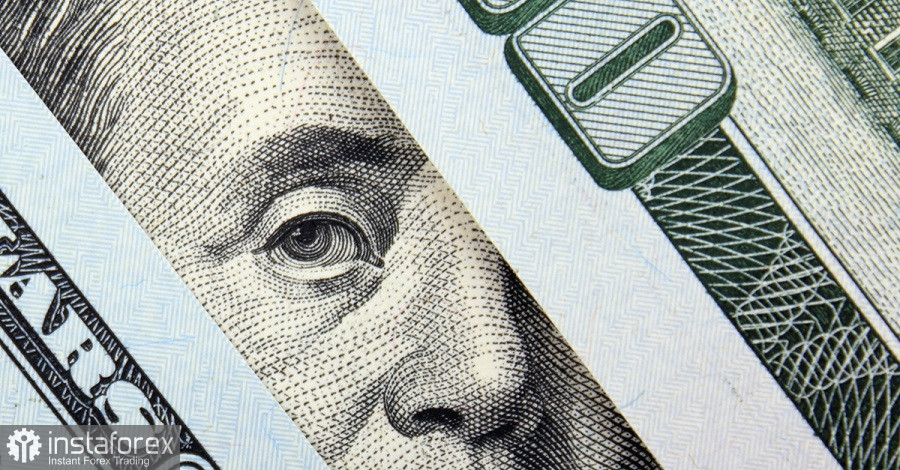The euro-dollar pair closed Friday at 0.9959. By the end of the trading week, EUR/USD bulls were able to neutralize all the bears' achievements, returning the lost points. However, traders still failed to overcome the key price barrier at 1.0000, despite the powerful upward momentum. In developing the upward trend, bulls need not only to overcome the parity level, but also to settle above 1.0050, which corresponds to the upper line of the Bollinger Bands indicator on the daily chart. Until this happens, it is quite risky to open long positions on the EUR/USD pair.
Friday's upward rush was more of an emotional nature - traders reacted too violently to the controversial Nonfarm data. But if we ignore the Friday release and scale the events of the last days, we can come to the conclusion that it is too early for the dollar bulls to "dry the oars". The results of the Federal Reserve's November meeting suggest that the greenback will continue to be in high demand, and especially against the euro (again, "thanks" to the not too decisive position of the European Central Bank).

But in order to assess further prospects, let's answer the question: why did the dollar fall in price on Friday? It is obvious that the greenback dipped across the market after the release of key data on the growth of the US labor market. This is not to say that the release was completely disappointing, but still many components came out in the red zone. The unemployment rate unexpectedly rose to 3.7% (from the previous low of 3.5%), while the average wage growth rate slowed to 4.7% (downward trend for the second month in a row). And although the growth rate in the number of employees came out in the green zone, in general, the published report left a negative impression. The data updated the words of Fed Chairman Jerome Powell, who said that the pace of monetary tightening will be slowed down, probably in December or February. It is obvious that the controversial Nonfarm tipped the scales towards the December scenario. Actually, for this reason, the dollar weakened its position throughout the market. According to the CME FedWatch Tool, there is now a 52% chance of a 50-point rate hike at the December meeting.
Therefore, if we consider the current situation "in the moment", then we can agree with the reaction of traders who en masse began to take profits ahead of the weekend, including for the EUR/USD pair. But will the Nonfarm report be able to continue to carry a large-scale correction on its shoulders? Here, as they say, I am tormented by "vague doubts".
The first counterargument: following the results of the November meeting, the market ignored Powell's message that the central bank is ready to slow down the pace of the rate hike. Moreover, in response to a related question, he outlined a very specific time frame, stating that this would happen "at the next or subsequent meeting." However, this message did not sink the US currency, because after Powell announced that the maximum level of the discount rate "will be higher than expected." He also spoke about the likely need for further rate hikes, even if inflation starts to slow down. After these words, the greenback strengthened its position throughout the market.
This suggests that in fact, the rate of increase is not so important for market participants if the peak of the completion of the current cycle is above the expected (5%) level.
The second counter-argument is that the issue of slowing down the pace of rate hikes is not resolved, but debatable. At least if we talk about the December meeting. In my opinion, traders made too hasty conclusions, relying on Nonfarm alone: inflation, not the labor market, will play a key role here. By the way, the head of the Boston Fed, Susan Collins, said that the central bank is still open to raising rates by 75 basis points - "if necessary."

In what case will the Fed need to raise the rate once again (the fifth in a row) in a 75-point increment? In my opinion, here the party's policy will be determined by inflation. And that is why the position of EUR/USD bulls is now so unsteady: after all, next week the scales may again tip in favor of the greenback.
The fact is that as early as next Thursday, November 10, data on inflation in the United States will be published. We learn the dynamics of the consumer price index for October. According to preliminary forecasts, the overall CPI rose by 8.0% (y/y) last month, while the core CPI rose by 6.5% (y/y). In September, let me remind you, the indicators came out at 8.2% and 6.6%, respectively. However, even if all components come out at the predicted level, the dollar may significantly strengthen its positions, as inflation growth will demonstrate an extremely weak slowdown rate. If the inflation report turns out to be in the green zone, we may become witnesses of another dollar rally.
Thus, it is premature to talk about a turning point in the EUR/USD pair in favor of the bulls. Despite a significant pullback to the upside, the pair is still trading as part of a large-scale downward trend, which may significantly increase in the coming week. Under conditions of such uncertainty, longs on the pair look risky: it is advisable to use corrective surges to open short positions with the first target at 0.9850. At this price point, the lower boundary of the Kumo cloud coincides with the middle line of the Bollinger Bands on the D1 timeframe.





















